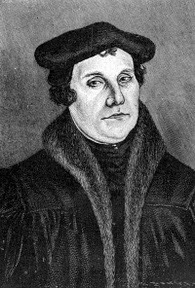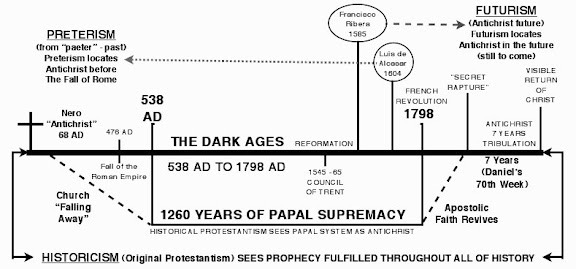The Reformation preachers unanimously identified the papal system as the Antichrist, and the Roman Church as Babylon—causing a mass exodus of believers out of the Catholic institution.
Because Rome realized that the Reformation could jeopardize her position as a religio-political power, she employed five strategies in what became known as the Counter Reformation. One of those strategies was the creation of futurism and preterism, two different interpretations of the prophecies in Daniel and Revelation. These interpretations contradicted the reformers' stance of historicism.
What are Futurism and Preterism?
The Oxford Handbook of Eschatology says that futurism “argues that Revelation looks beyond the first century to the period immediately before the end times. Thus the book was not written for those who received it, but for those living much later. Jesuit scholars after the Reformation refined this approach to prove that current attempts to identify the Pope as the Antichrist could not possibly be true since the Antichrist will not be revealed until far into the future, just before the Parousia (Christ’s Second Coming)."i
The same book explains that preterism sees Revelation only in terms of its immediate historical context:
Revelation [is] described [as] the plight of Christians in the late first century, and its apocalyptic symbols pointed directly to [the city of] Rome as the church’s persecutor...Most modern [preterist] interpreters...insist that the book was never intended to predict conditions or events beyond the first century.ii
According to futurism, the Antichrist is still to come. According to preterism, the Antichrist was in the past. However, this is not Biblical, as Jesus spoke in Matthew 24 of the great apostasy taking place in the future. Both of these false systems disagree with the reformers’ belief that the fulfillment of Biblical prophecy is taking place throughout history.
Throughout the Counter Reformation, preterism and futurism diverted attention away from prophecies identifying the Roman Church as Babylon and the papal system as the Antichrist.
How did these Counter Interpretations Start?
Here is a diagram to help us understand how these false interpretations were created and spread. In this diagram, you can see that the 1260 years of the Dark Ages was the period of papal supremacy prophesied inDaniel and Revelation.iii
Francisco Ribera
In 1585 Jesuit scholar Francisco Ribera (1537 - 1591) appears. He started the futurist interpretation by publishing a 500-page commentary on the book of Revelation. Ribera took the last “week” (seven day-years) of the 70-week prophecy of Daniel 9:25, divided it into two 3 ½ year periods, and applied it to a future Antichrist, while avoiding any application to the papal system.
Robert Bellarmine
Ribera’s views would have fallen away quickly if not for Robert Bellarmine (1542 - 1621), a cardinal who promoted Ribera’s ideas. His lectures were published as Polemic Lectures Concerning the Disputed Points of the Christian Belief Against Heretics of This Time. Froom describes these lectures as “the most detailed apology of the Catholic faith ever produced.” Froom also says they “became the arsenal for all future defenders and expositors.”iv
Luis de Alcasar
The diagram shows Jesuit scholar Luis de Alcasar (preterism’s creator) in 1604. His book, Investigation of the Hidden Sense of the Apocalypse, was published in 1614. Froom states this:
Applying the New Jerusalem to the Catholic Church, Alcazar contended that the Apocalypse describes the twofold war of the church in the early centuries—one with the Jewish synagogue, and the other with paganism—resulting in victory over both adversaries. Revelation 1 to 11 he applied to the rejection of the Jews and the desolation of Jerusalem by the Romans. Revelation 12 to 19 Alcazar allotted to the overthrow of Roman paganism and the conversion of the empire to the church, the judgment of the great Harlot being effected by the downfall of pagan idolatry; Revelation 20 he applied to the final persecution by Antichrist, and the day of judgment; and chapters 21 and 22, referring to the New Jerusalem, he made descriptive of the glorious and endless triumphant state of the Roman church.v
The Roman Church produced two contradictory interpretations of end-time prophecy, neither of which were true to Scripture.
Futurism and Preterism are Dangerous
In his book Truth Matters, Professor Walter Veith explains the following:
To counter the stand of the Reformers, the Catholic Church launched the counter-reformation spearheaded by the Jesuit Order. The doctrines of Preterism and Futurism, published by Alcasar and Ribera, two Jesuit priests, in 1585, redefined the reformation position on the Antichrist and shifted the emphasis away from the papacy to the Greek king Antiochus Epiphanus IV and to some tyrant who would persecute the Jews some time in the future.vi
Further, Professor Veith observes that by accepting these alternative approaches to Biblical prophecy, “the Protestant world...saw in it an opportunity to cease hostilities with Rome.”vii
Here the true danger is exposed: if Protestantism ceases to protest against the falsehoods of Rome, then there is no opposition to the Roman plans, and no check against the corruption of Biblical Christianity found in the Roman Catholic system. The Dark Ages can come again with a vengeance.

